
Lichenaula tuberculata is a moth of the family Xyloryctidae. It is endemic to Australia, more specifically the Australian Capital Territory and New South Wales.

Trigonodes hyppasia, the triangles or semi-looper, is a moth in the family Erebidae. The species was first described by Pieter Cramer in 1779. It is largely cosmopolitan, found throughout Borneo, Fiji, India, Maldives, Nepal, Sri Lanka, São Tomé and Príncipe, Taiwan, Thailand, Zimbabwe, northern Australia, and almost all African countries.
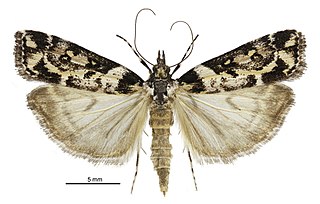
Eudonia diphtheralis is a species of moth in the family Crambidae. It is endemic to New Zealand.

Glaucocharis chrysochyta is a species of moth in the family Crambidae. This species was first described by Edward Meyrick in 1882. It is endemic to New Zealand and is found throughout the country. It inhabits native forest. Larvae appear to feed on moss and likely pupate there. Adult moths are on the wing from November to March. They fly at night and are attracted to light.
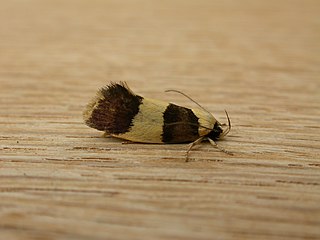
Telecrates laetiorella is a moth of the family Xyloryctidae. It is known from the Australian Capital Territory, New South Wales, Queensland, South Australia and Victoria.

Pasiphila plinthina is a moth in the family Geometridae. It is endemic to New Zealand and is found in both the North, South and Stewart Islands. It is on the wing mainly from June until September with occasional observations up to December, and is attracted to light. This species is similar in appearance to P. sandycias but can be distinguished from it as P. plinthina has palpi that are longer and has more blurred forewing markings.
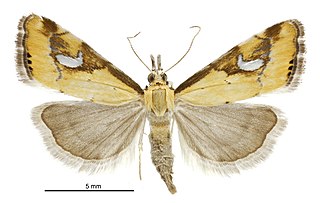
Glaucocharis lepidella is a species of moth in the family Crambidae. It was described by Francis Walker in 1866. It is endemic to New Zealand and is found in both the North and South Island. The species inhabits lowland to subalpine native forest. Larvae may feed on mosses. Adults are on the wing from November to February and are attracted to light.
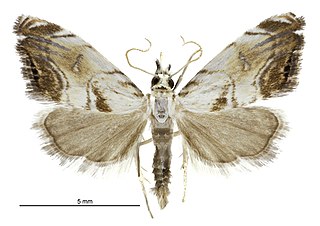
Glaucocharis harmonica is a moth in the family Crambidae. This species was described by Edward Meyrick in 1888. It is endemic to New Zealand and is found in the North and South Islands. It inhabits lowland to subalpine native forest. It has been hypothesised that there are two broods per year. The larval hosts are unknown. Adults are on the wing from October until January.
Ebbepterote is a monotypic moth genus in the family Eupterotidae. It was erected by Rolf G. Oberprieler, Wolfgang A. Nässig and Edward David Edwards in 2003. Its only species, Ebbepterote expansa, was described by Thomas Pennington Lucas in 1891. It is found in Australia, where it has been recorded from Queensland.
Gomphoscopa is a monotypic moth genus in the family Xyloryctidae. Its only species, Gomphoscopa catoryctopsis, is found in the Australian state of South Australia. Both the genus and species were first described by Oswald Bertram Lower in 1893.
Catoryctis truncata is a moth in the family Xyloryctidae. It was described by Thomas Pennington Lucas in 1902. It is found in Australia, where it has been recorded from New South Wales and Queensland.
Cryptophasa opalina is a moth in the family Xyloryctidae. It was described by Alfred Jefferis Turner in 1900. It is found in Australia, where it has been recorded from the Northern Territory, Queensland and Western Australia.

Cryptophasa albacosta, the small fruit tree borer, is a moth in the family Xyloryctidae. It was described by John Lewin in 1805. It is found in Australia, where it has been recorded from New South Wales, Queensland, South Australia, Tasmania and Victoria.
Cryptophasa phycidoides is a moth in the family Xyloryctidae. It was described by Thomas Pennington Lucas in 1901. It is found in Australia, where it has been recorded from New South Wales and Queensland.
Cryptophasa balteata is a moth in the family Xyloryctidae. It was described by Francis Walker in 1866. It is found in Australia, where it has been recorded from New South Wales, Queensland and South Australia.
Lichenaula laniata is a moth in the family Xyloryctidae. It was described by Edward Meyrick in 1890. It is found in Australia, where it has been recorded from New South Wales and Queensland.
Plectophila micradelpha is a moth in the family Xyloryctidae. It was described by Alfred Jefferis Turner in 1898. It is found in Australia, where it has been recorded from Queensland.
Agriophara curta is a moth in the family Depressariidae. It was described by Thomas Pennington Lucas in 1900. It is found in Australia, where it has been recorded from Queensland.

Phylomictis maligna is a moth in the family Depressariidae. It was described by Edward Meyrick in 1890. It is found in Australia, where it has been recorded from Victoria.
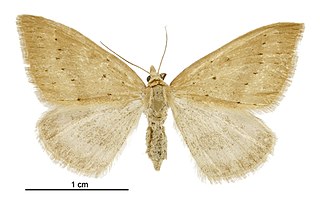
Asaphodes mnesichola is a species of moth in the family Geometridae. It is endemic to New Zealand and has been observed in the South Island. This species inhabits subalpine native scrub. Adults of this species are on the wing in January and February.










